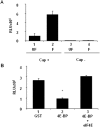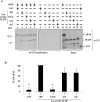A variant mimicking hyperphosphorylated 4E-BP inhibits protein synthesis in a sea urchin cell-free, cap-dependent translation system
- PMID: 19333389
- PMCID: PMC2659438
- DOI: 10.1371/journal.pone.0005070
A variant mimicking hyperphosphorylated 4E-BP inhibits protein synthesis in a sea urchin cell-free, cap-dependent translation system
Abstract
Background: 4E-BP is a translational inhibitor that binds to eIF4E to repress cap-dependent translation initiation. This critical protein:protein interaction is regulated by the phosphorylation of 4E-BP. Hypophosphorylated 4E-BP binds to eIF4E and inhibits cap-dependent translation, whereas hyperphosphorylated forms do not. While three 4E-BP proteins exist in mammals, only one gene encoding for 4E-BP is present in the sea urchin genome. The protein product has a highly conserved core domain containing the eIF4E-binding domain motif (YxxxxLPhi) and four of the regulatory phosphorylation sites.
Methodology/principal findings: Using a sea urchin cell-free cap-dependent translation system prepared from fertilized eggs, we provide the first direct evidence that the sea urchin 4E-BP inhibits cap-dependent translation. We show here that a sea urchin 4E-BP variant, mimicking phosphorylation on four core residues required to abrogate binding to eIF4E, surprisingly maintains physical association to eIF4E and inhibits protein synthesis.
Conclusions/significance: Here, we examine the involvement of the evolutionarily conserved core domain and phosphorylation sites of sea urchin 4E-BP in the regulation of eIF4E-binding. These studies primarily demonstrate the conserved activity of the 4E-BP translational repressor and the importance of the eIF4E-binding domain in sea urchin. We also show that a variant mimicking hyperphosphorylation of the four regulatory phosphorylation sites common to sea urchin and human 4E-BP is not sufficient for release from eIF4E and translation promotion. Therefore, our results suggest that there are additional mechanisms to that of phosphorylation at the four critical sites of 4E-BP that are required to disrupt binding to eIF4E.
Conflict of interest statement
Figures








Similar articles
-
eIF4E association with 4E-BP decreases rapidly following fertilization in sea urchin.Dev Biol. 2001 Apr 15;232(2):275-83. doi: 10.1006/dbio.2001.0206. Dev Biol. 2001. PMID: 11401391
-
After fertilization of sea urchin eggs, eIF4G is post-translationally modified and associated with the cap-binding protein eIF4E.J Cell Sci. 2007 Feb 1;120(Pt 3):425-34. doi: 10.1242/jcs.03339. Epub 2007 Jan 9. J Cell Sci. 2007. PMID: 17213333
-
Caspase cleavage of initiation factor 4E-binding protein 1 yields a dominant inhibitor of cap-dependent translation and reveals a novel regulatory motif.Mol Cell Biol. 2002 Mar;22(6):1674-83. doi: 10.1128/MCB.22.6.1674-1683.2002. Mol Cell Biol. 2002. PMID: 11865047 Free PMC article.
-
eIF4E activity is regulated at multiple levels.Int J Biochem Cell Biol. 1999 Jan;31(1):43-57. doi: 10.1016/s1357-2725(98)00131-9. Int J Biochem Cell Biol. 1999. PMID: 10216943 Review.
-
Control of the eIF4E activity: structural insights and pharmacological implications.Cell Mol Life Sci. 2021 Nov;78(21-22):6869-6885. doi: 10.1007/s00018-021-03938-z. Epub 2021 Sep 19. Cell Mol Life Sci. 2021. PMID: 34541613 Free PMC article. Review.
Cited by
-
An eIF4E-interacting peptide induces cell death in cancer cell lines.Cell Death Dis. 2014 Oct 30;5(10):e1500. doi: 10.1038/cddis.2014.457. Cell Death Dis. 2014. PMID: 25356869 Free PMC article.
-
mTOR Signaling in Protein Translation Regulation: Implications in Cancer Genesis and Therapeutic Interventions.Mol Biol Int. 2014;2014:686984. doi: 10.1155/2014/686984. Epub 2014 Nov 20. Mol Biol Int. 2014. PMID: 25505994 Free PMC article. Review.
-
Cyclin B Translation Depends on mTOR Activity after Fertilization in Sea Urchin Embryos.PLoS One. 2016 Mar 10;11(3):e0150318. doi: 10.1371/journal.pone.0150318. eCollection 2016. PLoS One. 2016. PMID: 26962866 Free PMC article.
-
Modulation of Intrinsically Disordered Protein Function by Post-translational Modifications.J Biol Chem. 2016 Mar 25;291(13):6696-705. doi: 10.1074/jbc.R115.695056. Epub 2016 Feb 5. J Biol Chem. 2016. PMID: 26851279 Free PMC article. Review.
-
Site-specific phosphorylation regulates the structure and function of an intrinsically disordered domain of the glucocorticoid receptor.Sci Rep. 2017 Nov 13;7(1):15440. doi: 10.1038/s41598-017-15549-5. Sci Rep. 2017. PMID: 29133811 Free PMC article.
References
-
- Mathews MB, Sonenberg N, Hershey JWB. Origins and Principles of Translational Control. In: Mathews MB, Sonenberg N, Hershey JWB, editors. Translational Control in Biology and Medicine. Cold Spring Harbor, NY: Cold Spring Harbor Laboratory Press; 2007.
-
- Davidson EH, Hough-Evans BR, Britten RJ. Molecular biology of the sea urchin embryo. Science. 1982;217:17–26. - PubMed
-
- Epel D. The initiation of development at fertilization. Cell Differ Dev. 1990;29:1–12. - PubMed
-
- Humphreys T. Measurements of messenger RNA entering polysomes upon fertilization of sea urchin eggs. Dev Biol. 1971;26:201–208. - PubMed
Publication types
MeSH terms
Substances
LinkOut - more resources
Full Text Sources
Miscellaneous

